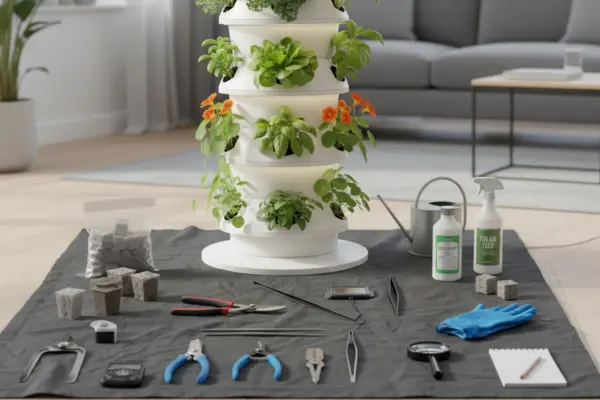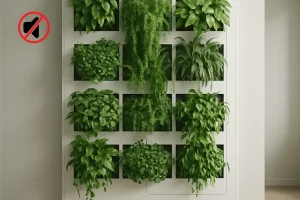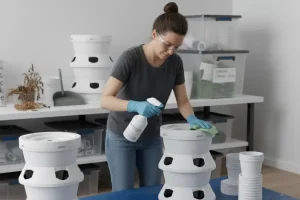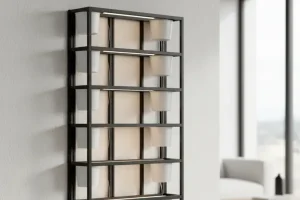Building up instead of out is a smart move, especially if you’ve got a balcony, a tiny patio, or just love the look of a living wall. But vertical gardening asks a little more from your toolkit than a traditional ground bed.
The right tools make installation safer, watering easier, and plant care faster. In this guide, we’ll walk through a practical, no-fuss toolkit that covers everything from mounting trellises to keeping vines in line so your garden grows up without your stress levels doing the same.
Why the Right Tools Matter
Vertical gardens concentrate plants into a smaller footprint. That’s great for harvests and looks, but it means small mistakes (loose bolts, uneven watering, dull pruners) can snowball quickly. A lean, well-chosen toolkit helps you:
- Install securely (no sagging frames or surprise wall damage)
- Water evenly (especially important when plants are stacked)
- Train growth (so flowers and veg don’t turn into a tangled curtain)
- Maintain quickly (snip, tidy, done)
Think of these tools as your garden’s support crew. You don’t need the fanciest version of each. Just reliable basics that fit your space and style.
The Core Toolkit
1) Tape Measure + Spirit Level
Why: Accurate measurements prevent “oops” moments like misaligned brackets or trellis rungs that plants can’t reach.
Tip: A small torpedo level is perfect for balconies; pair it with a 16–26 ft tape measure.
2) Stud Finder (for wall-mounted gardens)
Why: Anchoring into studs or masonry is the difference between a living wall and a falling wall.
Tip: For brick or concrete, use a masonry bit and proper anchors (see #3).
3) Mounting Hardware: Stainless Screws + Wall Anchors
Why: Vertical gardens get heavy when wet. Stainless or galvanized hardware resists rust.
What to get:
- Stainless steel screws (outdoors)
- Nylon or metal wall anchors (drywall)
- Masonry anchors (brick/concrete)
Bonus: Rubber washers help protect waterproof liners.
4) Trellises, Grids, and Plant Support Hooks
Why: Vines want something to hold. A sturdy support keeps growth tidy and encourages more blooms.
Options: Powder-coated metal trellises, wire grids with wall standoffs, or modular plastic panels.
5) Soft Plant Ties, Clips, and Velcro Straps
Why: Gentle support prevents stem damage while you guide growth.
Tip: Reusable Velcro is great for thicker canes (roses, bougainvillea); mini clips suit peas and cucumbers.
6) Bypass Pruners + Precision Snips
Why: Clean cuts heal faster and reduce disease.
Use:
- Bypass pruners: woody stems, canes, thicker vines
- Snips: leafy stems, deadheading, herbs
Care: Keep a small sharpener or honing stone handy.
7) Watering Wand or Narrow-Spout Watering Can
Why: Vertical layers are awkward. A long wand or slim spout reaches high pockets without soaking paths or walls.
Tip: Choose a wand with a gentle “shower” setting to protect potting mix.
8) Drip Irrigation Starter Kit + Simple Timer (Game-Changer)
Why: Even moisture = happier plants. Drip lines deliver water directly to each pocket or pot.
What to look for: 1/4″ tubing, adjustable emitters, a basic battery or plug-in timer.
Bonus: Add a pressure reducer for consistent flow.
9) Quality Potting Mix Scoop + Hand Trowel
Why: Clean fills prevent air gaps around roots. A scoop saves mess in tight spaces; a narrow trowel helps with pocket planters.
10) Moisture Meter (or your finger—no shame!)
Why: Overwatering is the #1 balcony killer. A basic meter helps you learn your system’s rhythm, especially with stacked planters.
11) Fertilizer Plan: Slow-Release + Liquid Feed
Why: Container and pocket gardens need steady nutrition.
How to use:
- Mix slow-release granules into the top layer at planting.
- Supplement with a diluted liquid feed every 2–4 weeks in peak growth.
12) pH Test Kit (Optional but Helpful)
Why: If leaves yellow or growth stalls, pH is often the quiet culprit, especially with hard tap water or hydroponic verticals.
Tip: Simple drop-test kits are inexpensive and easy to read.
13) Compact Hand Sprayer (for foliar feed & gentle pest control)
Why: Apply insecticidal soap, neem, or a foliar tonic precisely without drenching neighbors (plants or people).
Tip: Label one sprayer “pests only” to avoid mix-ups.
14) Cleaning Kit: Bucket, Soft Brush, Mild Detergent
Why: Salt buildup and algae sneak into vertical systems. A quick monthly wipe keeps everything fresh and prevents clogged emitters.
15) Protective Gear: Gloves + Safety Glasses
Why: Trellis wire + rose thorns + your eyes = you’ll only make that mistake once. Lightweight gloves protect without losing dexterity.
16) Indoor Add-Ons: LED Grow Light + Smart Plug/Timer
Why (indoors or shaded patios): Even, consistent light from top to bottom prevents leggy, pale growth.
Tip: A smart plug or timer automates 12–16 hours of light for leafy greens; 10–12 for flowering vines.
17) Label Maker or Weatherproof Tags
Why: In stacked systems, it’s easy to forget which pocket hosts which herb. Labels save guesswork at harvest time.
Nice-to-Haves That Make Life Easier
- Magnetic tool strip or wall caddy: Park pruners and ties right where you garden.
- Collapsible step stool: For safe, stable reach on tall walls.
- Inline filter (for drip): Reduces emitter clogs, especially with hard water.
- Soil scoop with built-in funnel: Cleaner fills in narrow pockets.
- Small fan (indoors): Improves airflow and reduces mildew on dense walls.
Actionable Setup: Build Your Kit in 8 Steps
- Measure and plan: Sketch your wall or trellis. Mark stud locations or decide on anchor types.
- Choose supports: Pick a trellis or grid sized to your wall with at least a 1 in air gap for ventilation.
- Buy hardware: Stainless screws, anchors, and washers to match your wall type (drywall, brick, concrete).
- Get plant-handling tools: Bypass pruners, precision snips, soft ties/clips.
- Sort watering: Watering wand or drip kit + basic timer; include a pressure reducer if using drip.
- Soil and feeding: Quality potting mix, scoop, slow-release fertilizer, optional liquid feed.
- Testing and care: Moisture meter, pH kit (optional), compact hand sprayer, cleaning bucket/brush.
- Label and store: Weatherproof tags and a small caddy so everything lives within arm’s reach.
Quick Tool Tips (Small Habits, Big Payoff)
- Sharpen monthly: Five minutes with a pruner sharpener keeps cuts clean and plants happier.
- Color-code emitters: Use different colored drippers for thirsty vs. drought-tolerant plants.
- Set “maintenance Mondays”: A weekly 10-minute check—ties, pests, moisture—prevents weekend emergencies.
- Use Velcro for training: Reposition easily as stems thicken; no more cutting away old ties.
- Pre-drill pilot holes: Reduces split wood and speeds installation on trellis frames.
Common Mistakes to Avoid (and Easy Fixes
- Using indoor screws outdoors
Problem: Rust stains and failing hardware.
Fix: Choose stainless or hot-dipped galvanized screws and anchors rated for exterior use. - Skipping proper anchors on drywall
Problem: Heavy planters pull out.
Fix: Use drywall anchors or, better yet, hit studs. For masonry, use masonry anchors and bits. - Uneven watering on tall setups
Problem: Top pockets dry, bottom ones drown.
Fix: Install drip with adjustable emitters; test flow and balance output. - Dull pruners tearing stems
Problem: Ragged cuts invite disease.
Fix: Sharpen blades; clean with a little rubbing alcohol between plants if you’ve had disease issues. - Overcrowding tools (and plants)
Problem: Tangles and frustration.
Fix: Keep a small wall caddy for tools; prune and thin plants regularly to maintain airflow. - Using garden soil in containers
Problem: Compaction, poor drainage, pests.
Fix: Always use a high-quality potting mix designed for containers. - No plan for overflow/drips
Problem: Water stains on walls and floors.
Fix: Add drip trays or a gutter at the base; practice a watering cycle and watch where water goes. - Ignoring light for lower tiers
Problem: Leggy, pale growth on bottom pockets.
Fix: Supplement with LED bars; aim for even coverage from top to bottom.
Budget-Friendly Starter Kits (Pick Your Path)
Bare-Bones Balcony Kit (most affordable):
Tape measure, mini level, basic trellis, stainless screws + anchors, soft ties, pruning snips, watering can with narrow spout, slow-release fertilizer, potting mix scoop, labels.
Set-and-Forget Watering Kit (still modest):
All of the above plus a drip starter kit, pressure reducer, and a simple timer.
Indoor Power Kit (for low-light spaces):
All of the above plus a 40–100W LED grow light (size depends on wall width) and a smart plug for automated schedules.
A Small Kit That Does Big Things
You don’t need a garage full of gadgets to grow up beautifully. With accurate measuring and mounting gear, gentle training tools, and a simple watering setup (ideally drip on a timer), you’ll handle 90% of vertical garden challenges before they start.
Add sharp pruners, a tidy feeding plan, and a quick weekly check-in, and your wall of green will stay healthy, lush, and easy to manage.
Ready to tailor this list to your space? Tell me whether you’re indoors or out, your wall material (drywall, brick, concrete), and how much sun you get. I’ll suggest exact hardware sizes, a drip layout, and a light plan that fits your garden like a glove.




